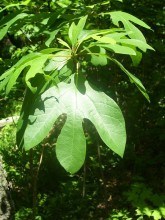
SASSAFRAS Trees
Sassafras albidum
Sassafras is native to the Eastern United States, and is a perennial, deciduous shrub or tree. It can be found growing from Maine all the way down to Central Florida!
Hardy in Zones 4-9b.
Sassafras has been cultivated since 1630 for its leaves, bark and wood. It is used for tea, oil and soap. Even the wood is used for fine construction.
Grows 27-54' tall and 18-24' wide.
Prefers moist, well-drained, sandy loam soils. Optimum soil pH is 6.0 to 7.0, but tolerates lower pH soils also. Just won't grow as large if soil is more dry or pH is more acidic. Must have full sun to thrive.
Sassafras is dioecious: meaning male & female trees. Females have larger flowers -- both are greenish-yellow and appear in early to mid-spring: Mar-Apr-May.
Dark shiny blue fruit barely 1/3" long appear by mid-summer or early fall and are largely exploited by birds and small animals.
Trees generally don't start flowering until about 10 yrs old.

Sassafrass flowers
Large bright green leaves can be either unlobed, 2-lobed (like a mitten) or 3-lobed, and may occur on the same branch or tree at random. Leaves are 3-6" long and are fragrant when crushed.
Sassafras leaves also turn a bright yellow-orange and red-orange in the fall.
The bark of young trees is green, but becomes more reddish-brown and rough/ridged on more mature trees. Bears, rabbits & squirrels love the bark, while the deer love the twigs and foliage.
Photo credits:
'Sassafras leaves' (top photo) published by permission from Wikipedia under the Creative Commons license found here. 'Sassafras flowers' (bottom photo) published by permission from Wikipedia under the Creative Commons license found here.
